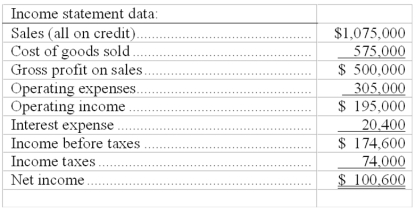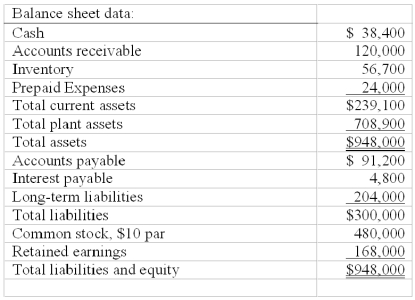Use the following information from the current year financial statements of a company to calculate the ratios below:
(a) Current ratio.
(b) Accounts receivable turnover. (Assume the prior year's accounts receivable balance was $100,000.)
(c) Days' sales uncollected.
(d) Inventory turnover. (Assume the prior year's inventory was $50,200.)
(e) Times interest earned ratio.
(f) Return on common stockholders' equity. (Assume the prior year's common stock balance was $480,000 and the retained earnings balance was $128,000.)
(g) Earnings per share (assuming the corporation has a simple capital structure, with only common stock outstanding).
(h) Price earnings ratio. (Assume the company's stock is selling for $26 per share.)
(i) Divided yield ratio. (Assume that the company paid $1.25 per share in cash dividends.)


Definitions:
Rabbit/Duck
An example of a reversible figure that can be seen as either a rabbit or a duck, illustrating the concept of perceptual ambiguity.
Mental Scan
The cognitive process of mentally reviewing or searching through stored information or visual images in the mind.
Kosslyn
Refers to Stephen Kosslyn, a psychologist known for his work in the field of cognitive psychology, particularly in visual cognition and mental imagery.
Q21: Corona Company's balance sheet accounts follow: <br><img
Q59: Extraordinary items are reported in the operating
Q95: A mixed cost:<br>A) Requires the future outlay
Q109: A discount on bonds payable occurs when
Q114: The appropriate section in the statement of
Q141: Current assets divided by current liabilities is
Q143: What is a corporation? Identify the key
Q152: The comparison of a company's financial condition
Q165: Bonds with a par value of less
Q181: A company's only treasury stock transactions for